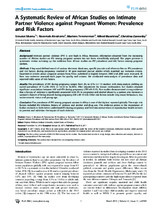| dc.contributor.author | Shamu, Simukai | |
| dc.contributor.author | Abrahams, Naeemah | |
| dc.contributor.author | Temmerman, Marleen | |
| dc.contributor.author | Musekiwa, Alfred | |
| dc.contributor.author | Zarowsky, Christina | |
| dc.date.accessioned | 2012-11-13T12:28:06Z | |
| dc.date.available | 2012-11-13T12:28:06Z | |
| dc.date.issued | 2011 | |
| dc.identifier.citation | Shamu, S., et al. (2011). A systematic review of African studies on intimate partner violence against pregnant women: Prevalence and risk factors. PLoS ONE, 6(3): e17591. | en_US |
| dc.identifier.issn | 1932-6203 | |
| dc.identifier.uri | http://hdl.handle.net/10566/461 | |
| dc.description.abstract | Background: Intimate partner violence (IPV) is very high in Africa. However, information obtained from the increasing
number of African studies on IPV among pregnant women has not been scientifically analyzed. This paper presents a
systematic review summing up the evidence from African studies on IPV prevalence and risk factors among pregnant women.
Methods: A key-word defined search of various electronic databases, specific journals and reference lists on IPV prevalence
and risk factors during pregnancy resulted in 19 peer-reviewed journal articles which matched our inclusion criteria.
Quantitative articles about pregnant women from Africa published in English between 2000 and 2010 were reviewed. At least two reviewers assessed each paper for quality and content. We conducted meta-analysis of prevalence data and
reported odds ratios of risk factors.
Results: The prevalence of IPV during pregnancy ranges from 2% to 57% (n = 13 studies) with meta-analysis yielding an
overall prevalence of 15.23% (95% CI: 14.38 to 16.08%). After adjustment for known confounders, five studies retained
significant associations between HIV and IPV during pregnancy (OR1.48–3.10). Five studies demonstrated strong evidence
that a history of violence is significantly associated with IPV in pregnancy and alcohol abuse by a partner also increases a
woman’s chances of being abused during pregnancy (OR 2.89–11.60). Other risk factors include risky sexual behaviours, low
socioeconomic status and young age.
Conclusion: The prevalence of IPV among pregnant women in Africa is one of the highest reported globally. The major risk
factors included HIV infection, history of violence and alcohol and drug use. This evidence points to the importance of
further research to both better understand IPV during pregnancy and feed into interventions in reproductive health services
to prevent and minimize the impact of such violence. | en_US |
| dc.language.iso | en | en_US |
| dc.publisher | Public Library of Science | en_US |
| dc.rights | © 2011 Shamu et al; licensee Public Library of Science. This is an Open Access article distributed under the terms of the Creative Commons Attribution License (http://creativecommons.org/licenses/by/2.0), which permits unrestricted use, distribution, and reproduction in any medium, provided the original work is properly cited | |
| dc.source.uri | http://dx.doi.org/10.1371/journal.pone.0017591 | |
| dc.subject | Intimate partner violence | en_US |
| dc.subject | Pregnant women | en_US |
| dc.subject | Prevalence | en_US |
| dc.subject | Risk factors | en_US |
| dc.subject | HIV | en_US |
| dc.subject | Africa | en_US |
| dc.title | A systematic review of African studies on intimate partner violence against pregnant women: prevalence and risk factors | en_US |
| dc.type | Article | en_US |
| dc.privacy.showsubmitter | false | |
| dc.status.ispeerreviewed | true | |
| dc.description.accreditation | Web of Science | en_US |

